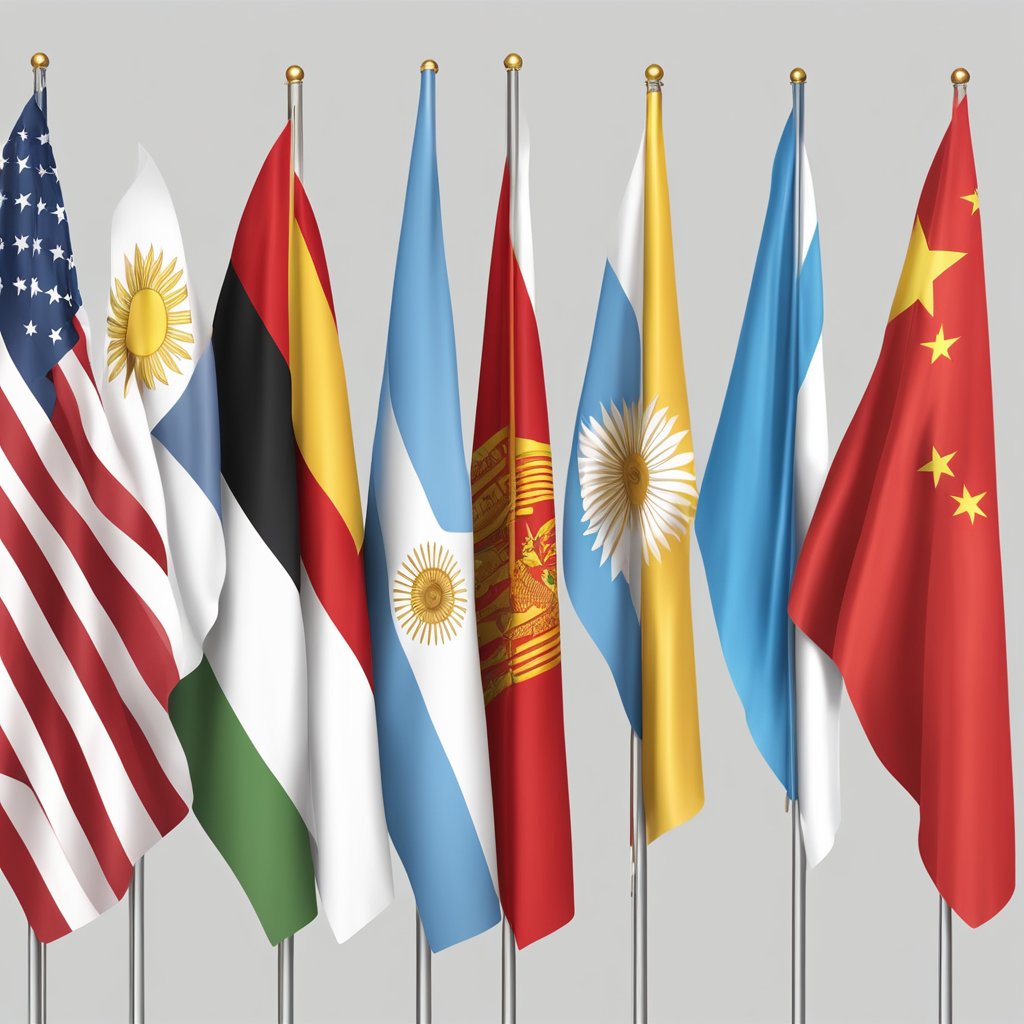Brazil stands as an influential player in the global trade ecosystem, with a vibrant export and import profile that integrates it deeply into international commerce. As a massive country with a diverse economy, Brazil exports an array of commodities and manufactured goods to markets around the globe. Its strategic position in South America, coupled with its vast natural resources, positions Brazil uniquely in the trade network. Understanding the intricacies of Brazil’s trade relations, including key export products like soybeans, iron ore, and crude petroleum, and major import goods such as machinery, electrical equipment, and oil, provides insight into its global economic stature.
The landscape of Brazil’s trade is colored by a variety of factors, from geographic advantages to complex economic policies shaping its bilateral and multilateral relationships. Its leading trade partners, including major economies such as China, the United States, and the European Union, play pivotal roles in Brazil’s overall trade balance. These relationships are further influenced by trade agreements and memberships in economic blocs like Mercosur, which drive regional trade dynamics. Unpacking Brazil’s diverse trade portfolio reveals how specific sectors contribute to the country’s economic growth, while also surfacing the challenges and opportunities that lie ahead in an evolving global market.
Table of Content
ToggleKey Takeaways
- Brazil’s global trade network involves a diverse export-import dynamic, including a wide array of commodities and manufactured goods.
- The country’s leading trade partners are crucial to its economic balance, with China, the US, and the EU holding significant positions.
- Economic policies, trade agreements, and membership in blocs like Mercosur impact Brazil’s trade relationships and opportunities.
Overview of Brazil’s Trade Landscape
Brazil’s economy relies significantly on trade, with international trade playing a vital role in its GDP and development. The nation’s trade structure underscores its status as a global player, with a complex web of import and export relationships.
Significance of Trade to Brazil’s GDP
Trade is a crucial component of Brazil’s economic growth and represents a substantial portion of the country’s GDP. Brazil benefits from a diverse range of exports, including soybeans, iron ore, and crude petroleum, which contribute to its strong trade surplus. On the import side, Brazil’s major purchases include refined petroleum, vehicle parts, and pharmaceuticals, reflecting its industrial and domestic needs. International trade not only influences Brazil’s gross domestic product (GDP) but also affects the standard of living and purchasing power parity for its citizens.
Trade Indicators and Development
Brazil’s trade performance can be measured through various development indicators:
- Exports and Imports: The balance between Brazil’s exports and imports implies the health of its trade sector.
- Trade Balance: A positive trade balance signifies that Brazil is exporting more than it is importing, thereby adding to its GDP.
- Market Diversification: Brazil engages in trade with numerous countries, reducing dependency on any single market.
- Competitiveness: The country continually seeks to enhance its competitiveness in the global market through advancements in infrastructure and technology.
The influence of international trade on Brazil’s economy extends to its role in driving innovation, creating jobs, and determining the overall development trajectory of the nation. Through strategic partnerships and trade agreements, Brazil aims to further integrate into the global economy and promote sustainable economic development.
Brazil’s Export Profile
Brazil’s export profile is robust, with a diverse array of products ranging from agricultural to mineral commodities, which play an integral role in the country’s economy. The nation’s export landscape showcases sustained trade relationships with countries worldwide, cementing its position as a leading global trader.
Major Exported Products
Brazil’s export basket is characterized by significant variety, with soya beans, iron ore, meat, and coffee among its most prominent exported items. Agriculture is a powerful sector, with soya beans not just feeding the nation’s economy but also international markets. In addition to agricultural goods, ores hold a pivotal place in Brazil’s exports, with iron ore being a cornerstone of Brazil’s mineral exports.
Key Export Destinations
Brazil’s key export destinations are indicative of its strategic trade partnerships. China stands as Brazil’s largest export market, especially for commodities like iron ore and soya beans, which are in high demand for supporting China’s expansive industrial and consumer sectors. The United States follows, with a variety of Brazilian products forming part of the bilateral trade. The Netherlands and Germany also feature prominently on the list of Brazil’s top trading partners, reflecting the country’s well-established foothold in European markets.
Brazil’s Import Dynamics
Brazil’s import landscape is shaped significantly by the commodities it brings in and the countries from which these products originate. The nation strategically imports to supplement domestic demands and sustain its economic growth.
Main Imported Goods
Brazil is a major importer of a diverse range of goods essential to its economy. The portfolio includes vehicles, with cars and auto parts being instrumental to its transport sector. The import of chemical products also features prominently, catering to various industrial and consumer needs. Notably, petroleum oils and mineral fuels are critical imports, fueling the energy and manufacturing sectors. Additionally, electronics are significant; they are essential for the technological advancement and consumer electronics market within the country.
Principal Import Sources
The primary trade partners from which Brazil sources its imports are crucial to understanding the country’s import dynamics. China stands out as the largest import partner, providing a wide array of products from electronics to machinery. Following China, the United States plays a key role as a supplier of high-tech goods and services. Neighboring Argentina also figures significantly, especially in the automotive sector. Lastly, the Netherlands serves as an important gateway for European goods, contributing to the diverse nature of Brazil’s imports. These partnerships reflect Brazil’s strategic trade relationships and its position as a significant importer in the global market.
Leading Trade Partners and Bilateral Relations
Brazil maintains robust trade relations with several key global partners, most notably China and the United States. These partnerships are not just pivotal in terms of trade volume; they also deeply influence Brazil’s economic strategies.
Trade with China
China has emerged as Brazil’s top trading partner, representing a significant portion of Brazil’s export market, particularly in commodities. In recent years, Brazil has seen a surge in commodity exports to China, including soybeans and iron ore, which have bolstered the trade balance in Brazil’s favor. Conversely, the import ledger records high volumes of manufactured goods entering Brazil from China.
- Exports to China:
- Commodities (mainly soybeans, iron ore)
- Imports from China:
- Manufactured goods
- Trade Balance: Favorable to Brazil
Trade with the United States
The United States stands as one of Brazil’s most significant trading partners after China. As an importer, the U.S. primarily focuses on Brazilian industrial goods, petroleum, and agricultural products. On the flip side, Brazil imports a wide range of goods from the U.S., including high-tech products and equipment. Bilateral initiatives and dialogues have been in place to bolster trade and resolve barriers, maintaining a relatively balanced trade relationship.
- Exports to the U.S.:
- Industrial goods, petroleum, agriculture
- Imports from the U.S.:
- Technology, machines
- Trade Balance: Relatively balanced
Trade Agreements and Economic Blocs
Brazil’s integration in various economic blocs and its engagement in numerous free trade agreements underline its significance in international trade, both within Latin America and globally.
Mercosur and Its Impact
Mercosur, a prominent South American trade bloc, plays a fundamental role in Brazil’s trade strategy. Comprising Argentina, Brazil, Paraguay, and Uruguay, this economic bloc aims to facilitate trade through the reduction of tariffs and trade barriers among member states. For Brazil, Mercosur has been a platform to bolster economic ties within the region and negotiate joint trade policies with other countries and economic blocs.
Free Trade Agreements
Brazil actively pursues free trade agreements (FTAs) to enhance its international trade reach. FTAs are instrumental in expanding Brazil’s export profile by minimizing barriers and fostering trading partnerships. The European Union (EU), being Brazil’s significant trading partner, has been engaged in discussions regarding a bilateral trade agreement, aimed to improve economic collaboration. These agreements signify Brazil’s approach to diversifying its trade alliances beyond Latin America to strengthen economic growth and global trade influence.
Market-Specific Trade Aspects
Brazil’s trade profile is distinguished by significant exports of agricultural products and certain manufactured goods. These sectors are cornerstones of Brazil’s trade, influenced by market demand and bilateral agreements with significant trading partners.
Agricultural Products and Commodities
Brazil stands as a leading exporter of agricultural commodities. Notable products such as soybeans, cane sugar, and coffee dominate its agricultural export portfolio. The country’s soybean exports have been a particular area of growth, driven by global demands for both food and feed production. It is crucial to the agricultural trade that these commodities maintain their market-specific competitive advantages, including quality and pricing. Here are some specifics:
- Soybeans: Brazil is one of the world’s largest exporters, capitalizing on high protein content that is sought after for livestock feed.
- Cane Sugar: The nation leads in sugarcane production, with a reputation for cost-effective and sizable outputs.
- Coffee: Brazilian coffee exports benefit from the country’s varied climate, enhancing the beans’ distinctive flavors and aromas.
Manufactured Goods
In terms of manufactured goods, Brazil has developed a strong market niche for certain products. The country has seen substantial export increases in areas such as motor vehicles, monolithic integrated circuits, and various forms of electrical machinery. The trade in these goods is characterized by complex global value chains and technological innovation. Here are key insights:
- Motor Vehicles: Brazilian manufacturers have expanded into new markets, particularly Latin America, with vehicles that cater to local preferences and regulations.
- Monolithic Integrated Circuits and Digital Technology: These sectors showcase Brazil’s advancements in technology and its integration into the digital economy.
- Electrical Machinery: There’s an increasing demand for Brazilian electrical machinery, reflecting the country’s ability to compete in global markets.
Trade Challenges and Opportunities
Brazil’s trade dynamics present a complex interplay of challenges and opportunities that impact the nation’s economy and its population. Understanding the trade deficit and surplus across product groups and services is key to navigating and addressing trade barriers, while also capitalizing on potential growth sectors.
Trade Deficit and Surplus Analysis
Brazil’s trade relationships often fluctuate, resulting in periods of trade deficits and surpluses. A trade deficit occurs when the country imports more goods and services than it exports, which can strain the economy. Conversely, a trade surplusboosts the economic climate by earning more from exports than it spends on imports.
Trade Deficits:
- Challenges include increased foreign debt.
- Resulting trade barriers can restrict market access.
Trade Surpluses:
- Opportunities arise with a growing economy.
- May lead to stronger international relationships.
Analyzing these trade patterns, Brazil identifies which product groups lead to surpluses and which sectors contribute to deficits, adapting its trade strategies accordingly to optimize its economic health.
Potential Growth Sectors
The Brazilian economy has diverse sectors ripe for growth, many of which already enjoy a global footprint. Product groups such as soy, iron ore, and petroleum are consistently strong in exports. Meanwhile, services, especially in technology and tourism, are emerging as significant growth areas. These sectors face challenges like infrastructure bottlenecks and complex taxation, but they also hold substantial opportunities:
Product Groups with Growth Potential:
- Agriculture: Sustainable practices can open new markets.
- Mining: Innovations can improve efficiency.
Services with Growth Opportunities:
- Technology services can attract foreign investments.
- Tourism can leverage Brazil’s cultural and natural riches.
Addressing barriers such as stringent regulations and fostering a population skilled in these sectors can unlock these opportunities, solidifying Brazil’s position in the international trade arena.
Foreign Trade Policy and Regulation
Brazil’s foreign trade policy and regulation framework is designed to balance the goals of market access for its exports and protection for its domestic industries. The country has faced international trade challenges, including protectionist biases against its export goods.
Customs and Tariffs
Customs procedures in Brazil are meant to protect local industries while also complying with international trade agreements. The country imposes tariffs and regulatory measures on imports to manage market entry and domestic price levels. These tariffs vary depending on the product and the trade relations with partner countries. For instance, intra-regional trade with Latin America might enjoy more favorable tariff rates under the Mercosur economic bloc, reducing trade barriers within the region.
Economic Diplomacy
Brazil employs modern economic diplomacy to forge trade relationships and negotiate agreements. The aim is to enhance market access for Brazilian exports and attract foreign investment. The country actively participates in the World Trade Organization (WTO), advocating for rules that would favor its trade interests. Moreover, Brazil engages in bilateral and multilateral negotiations to expand its network of free trade agreements, seeking to diversify its trading partners and reduce dependence on any single market.
Impact of Global Economic Trends
The global economic landscape significantly influences Brazil’s trade relationships. Specific trends in the global economy shape Brazil’s interactions with its trading partners.
Influence of Global Markets
Trade partners: Brazil’s major trading partners reflect global economic shifts. The nation maintains robust commercial ties, particularly with countries in Asia, Europe, and the USA. China’s position as Brazil’s largest trading partner underscores Asia’s vital role in Brazil’s external trade dynamics, which can be attributed to China’s vast demand for Brazilian commodities.
Trade indicators: Brazil’s export and import indices reveal the country’s responsive adaptation to the changing tides of international commerce. These indicators give insights into how Brazil positions itself in product groups and services trade.
Services and product groups: As global market demands evolve, Brazil diversifies its service offerings and product groups. This strategic adjustment enables the Brazilian economy to be less susceptible to the vagaries of singular markets and more integrated into the world economy.
Brazil’s trade with Europe is multifaceted, involving not only goods but also services, marking a comprehensive economic interaction. Meanwhile, the USA remains a critical market for Brazil’s various export categories, from agricultural produce to manufactured goods.
The global economy today places Brazil in a unique position to leverage its vast natural resources and growing service sector, forging pathways that align with dominant economic trends and regional trade agreements.
Brazil’s Sector-Specific Trade
Brazil’s sector-specific trade is strongly tied to its abundant natural resources and sophisticated agricultural sector, with significant exports of mineral fuels and ores, as well as a considerable market for agricultural imports and exports.
Mineral and Resource Exports
Brazil is a major player in the global mining industry, particularly in the production and export of mineral fuels and iron ores. In the realm of mineral fuels, Brazil has developed a substantial oil and gas sector and actively trades these resources on the international market. China remains one of Brazil’s key trading partners in this sector, consuming a significant portion of Brazilian iron ore to fuel its own industrial growth.
- Iron Ore: Brazil is the second-largest exporter of iron ore, which is essential for the construction and manufacturing industries worldwide.
- Mineral Fuels: The country also deals extensively in other mineral fuels, including oil and related products.
Agricultural Sector Imports and Exports
When it comes to agriculture, Brazil is a heavyweight, particularly in products like soya beans. Not only does it supply countries around the globe with critical raw materials, but it also imports agricultural products to diversify its domestic food supply.
- Soya Beans: Brazil’s status as one of the world’s largest producers and exporters places it at the center of the global soya bean trade.
- Agricultural Products:
- Exports: Comprising a variety of items such as sugar, coffee, and beef, Brazilian agricultural exports are sought after for their quality and volume.
- Imports: Brazil also imports agricultural goods, sourcing commodities which are not locally produced or are cheaper to purchase from other countries.
Both sectors—minerals and agriculture—play vital roles in defining Brazil’s economic interactions with China and other countries, grounding its stature as a pivotal trading partner on the global stage.
Frequently Asked Questions
Brazil’s international trade landscape is diverse, with key partnerships and export commodities that position it strategically on the global stage. This section aims to address common queries related to Brazil’s import and export dynamics.
Who are Brazil’s primary import partners in international trade?
Brazil’s main import partners include countries like China, the United States, Argentina, and Germany, which significantly contribute to Brazil’s imports, providing a range of products from electronics to automotive parts.
Which commodities constitute Brazil’s top imports?
Brazil primarily imports petroleum products, electronics, machinery, and vehicles. The country also brings in substantial amounts of chemicals and pharmaceuticals to meet its domestic demands.
How does Brazil’s export portfolio break down by country?
China is the top destination for Brazil’s exports, followed by the United States and Argentina. These exports mainly consist of soybeans, raw materials, and iron ore, illustrating Brazil’s role as a key supplier of agricultural and mineral commodities.
What are the major sectors in Brazil’s export economy?
Brazil’s export economy thrives on sectors such as agriculture, mining, and manufacturing. Agriculture exports feature soybeans and beef, while mining exports are led by iron ore and gold. The manufacturing sector is known for exporting automotive and aerospace products.
What recent trade agreements have influenced Brazil’s trade dynamics?
The Economic Partnership Agreement between Mercosur countries, which includes Brazil, and the European Union has been a significant development, aiming to create opportunities to increase trade flow and investment.
In which industries is Brazil considered the leading exporter globally?
Brazil holds a prominent global position as the leading exporter of soybeans, coffee, and sugarcane. The country is also a top exporter of beef and poultry, reflecting its strength in the agribusiness sector.












